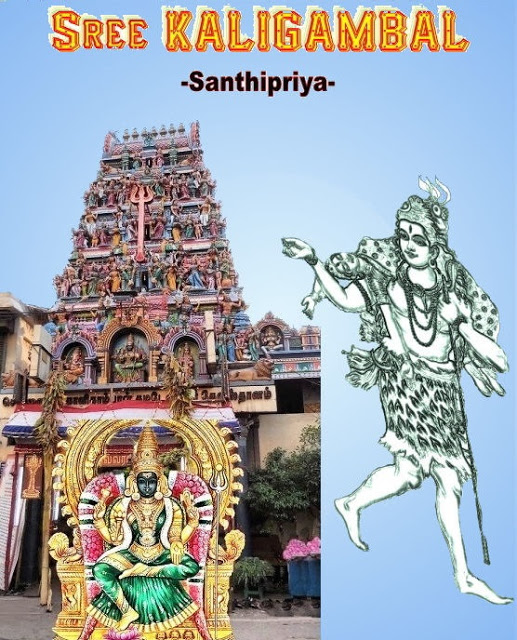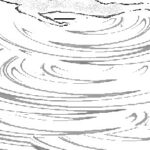
One of the most famous and several centuries year old temple for Goddess Kaligambal,an aspect of Goddess Kamatchi Amman exists in a busy and congested street in heart of Chennai, Tamilnadu. Unfortunately many are unaware of its glory and the historical importance of the deity. Popularly known as Kaligambal Devi Temple, the main deity Kaligambal reportedly manifested in Chennai sea shore some 2000 years back and stayed there for several years before moving into the present temple site. Some are of the opinion that the temple deity is as old as 400 years only, while others dispute the claim to state that though the temple structure is less than 400 years old, the deity enshrined in it is as old as 2000 years. This argument gains strength from the fact that Adi Sankara who lived 2000 years ago reportedly consecrated Artha Meru Yanthra below her leg in order to repress her anger so that the devotees who visit the shrine to pray her will not face her fury. Since the present temple structure has been raised only after 1640 when East India Company(British rulers) reached Chennai then called Madras city, the mute question is how could Sri Adi Sankara have consecrated the Yanthra 2000 years ago? Read the entire story to understand the history.
The history of the temple as narrated by word of mouth folklore goes thus. Several centuries ago an unknown female deity (Present Kaligambal) manifested in the form of a small idol on the seashore in Chennai. Nobody knew how it came there or who placed it at that spot. However since the deity was found on the seashore, people who lived in and around called the deity as Kadal Kanni meaning small girl from Sea. Thereafter when the fishermen found that the small female deity remained unaffected by the sea and even inclement weather they kept her on a raised platform and made it a practice to enter into the sea only after offering worship to her. They found that lot of luck befell on them by way of large cache of fishes ever since they commenced worshiping her. Thus in a way she became their guardian deity. They were unaware of the fact that the statue or idol was the iconic body of Goddess Parvathi who was to manifest as Kanchi Kamatchi Amman of Kancheepuram and who left it (the body) there shelved with her divine energies before proceeding to Mangadu for penance. The detailed story on this is narrated in later part of this story. Simultaneously a group of Viswakarmas (the architect of the gods) who lived in and around sea shore too mainly worshiped the deity found on the seashore after constructing a very small shrine (details not known, whether it was thatched hut structure or a mud house) and adapted the deity as their tutelary deity, the reason being Viswakarmaswere considered to be architects of divine and scalped and engraved the statues of deities required for temple constructions. Since the present day temple has been ultimately established and maintained by Viswakarmas this version has been considered to be true.
Those were the days when Tamilnadu then called Madras had three areas near seashore which were predominantly inhabited by fishermen, economically poor and socially lower in status. Those were the days when the division in class and caste were also high in order. Therefore the settlements around seashore were called Kuppams meaning small areas like hamlets. When East India Company decided to entrench in south, they first began purchasing Kuppams near the seashore. The main reason for their decision to buy lands near seashore was meant to ease the transportation of men and material in future. One such prominent Kuppams called Madras Kuppam was located near Parrys Corner and the Britishers first purchased the said land to establish a fort there. Unfortunately the small shrine of Kadal Kanni came within the fort area which came under the purview of Military wing of the rulers (British). Even after the land became the property of the Britishers, the Viswakarmas continued to offer worship to the unknown deity inside the fort area. The Britishers could not prevent the worship. As time passed by twist of tongue of devotees the Kadal Kanni came to be called Kadal Kali meaning the Kali Devi of seashore.
The Britishers felt that frequent visit by devotees inside Fort area could breach their security and therefore in the year 1640 they decided to get the shrine shifted elsewhere without offending the feelings of Viswakarmas and approached them with an offer to bear the entire cost of shifting the shrine to any other place of their choice. Viswakarmas too had no hesitation in agreeing to the proposal as it would help them keep away from the interference of British Military personnel who were basically anti Hindus. Like shifting the bag and baggage, the Viswakarmas were successful in shifting the shrine to the present temple site in Thambu Chetty Street in heart of Chennai. When a suitable site for temple construction was searched the Goddess reportedly sent signals in several ways to her devotees indicating the place where the temple for her shall have to be established (the place where for some time she remained in penance before proceeding to Mangadu) and hence the present temple site was chosen. Since the temple was established in heart of Chennai before 400 years or so, the origin of the temple came to be disputed though the believers firmly aver that the original shrine established on the bank of sea shore was 2000 years old and that was relocated to Thambu Chetty street and therefore the temple indeed belonged to pre 2000 period.
The spiritual gurus while commenting on the present temple site opine that who others viewed as Kadal Kali was actually Goddess Parvathi who may have sat in penance for few days on the banks of seashore and disturbed by frequent visits of devathas and others, she may have shifted to the present temple site of Kaligambal, however remaining invisible to humans, and went to seashore everyday to take bath and returned back before sunrise to escape the attention of onlookers. This is how when the Goddess commenced onward journey to Mangadu for penance, her lifeless body in the form of idol with her divine energy infused in it was left buried in seashore. The Goddess wanted that at appropriate time she decides the sea sand would clear the way to show the idol. It was the same idol which was worshiped by fishermen and Viswakarmas centuries later. When Adi Sankara had the vision of Goddess Parvathi in the form of Kadal Kali in the present temple site he found the Kadal Kali exhibiting fierce energy and remained in ugraha (fierce) form and therefore for the benefit of mankind he converted her fiery form to that of sober one which is the present form of Goddess Kaligambal.Thus the temple for the devi has actually come up in the same site inside city where she remained in tapas,invisible to humans before proceeding to Mangadu.
As per the folklore on the history of the temple, Kaligambal had initially manifested on sea shore as Kadal Kali and when the Devathas from the sea saw her staying in isolated land, they thought that she was a divine Princess from Sea God i.e Kadal Kanni and therefore began offering their services and prayers to beget reward for previous birth virtues. This is perhaps the reason why the Kadal Kannis remain the Parivara Devathas in the temple. When the presence of Kadal Kali spread amongst the inhabitants of the nether world, the message reached devaloga too and therefore the devathas from devaloga began visiting the devi to offer worship to get rid of their curses of various sins they had committed and to beget reward for previous birth virtues. Besides Devathas those who worshiped her on seashore included visitors like Varunan, Guber, Devendra, Rishies like Pulasthiya, Agasthiya, Parasar, Viswakarma etc. The legend has it that God Guber reportedly acquired lot of wealth only after he began worshiping Kaligambal, then known as Kadal Kali. There is no verifiable historical proof for these folklores, nevertheless the belief continued unabated amongst those who reposed faith in her. However all those events were happening invisible to human eyes. As per the Pundits the greatness of the temple and its merit is found in epics like Machcha Puran, Vaamana Puran, Koorma Puran, Linga Puran and Bhavishya Puran.
When Kadal Kali manifested on sea shore as shadow Goddess of Goddess Kamatchi Amman she was reportedly possessed with the fiery energy of Goddess Kali, though her appearance was benign countenance. After she was shifted from seashore to the heart of the city, she came to be affectionately called Kaligambal. How did she attain the name Kaligambal from that of Kadal Kali? The learned Pundits believe that Kaligambal being shadow deity of Goddess Kamatchi Amman i.e. Devi with aspects of Kali possessing fiery energy + Ambal exhibiting compassion, both combined together came to be called Kali + Ambal i.e. Kaligambal (in Tamil ‘anbu’ meant love and ‘bal’ meaning through i.e. Devi’s compassion through love got twisted as Ambal).The version of some other spiritual Gurus has been that since she manifested on earth to save mankind from the miseries of Kali Yug (in the tenth avatar of Vishnu), she was named as Kaligambal i.e ‘Kali kaalaththil kaakka vantha Ambal’ meaning the female deity who manifested in Kali Yug to save the mankind from miseries. Initially called Kali, once seated in the present temple site she began to be addressed as Kaligambal. Only after several centuries later, spiritual gurus identified her to be the aspect of Goddess Parvathi, the one who created divine Trinity.
Word of mouth spread folklore further mention that the statue of Kaligambal enshrined in the temple has been designed and engraved by Vishvakarma of Devaloga who was dispatched to earth in human form by Kamatchi Amman to ensure that the deity resembled the same form of hers as manifested on seashore. It is unclear whether the consecrated statue in the temple is original icon surfaced from the seashore or carved out statue by Viswakarmas while enshrining it during temple construction. Goddess Kaligambal’s two arms in her temple are reportedly to that of Goddess Saraswathi and Goddess Lakshmi. Remember that Goddess Kanchi Kamatchi too has Goddess Saraswathi and Goddess Lakshmi as her eyes in the Kanchi temple. This fact thus strengthens the argument that Goddess Kaligambal is one of the aspects of same Goddess Kamatchi Amman of Kancheepuram.
There is yet another interesting revelation in folklore to the effect that the four deities in Kancheepuram, Tiruvanaikkovil, Chennai Kaligambal and Mangadu are one and the same and are basically interconnected with the common story of Goddess Parvathi (connected to Goddess Kamatchi Amman, an emanation of Goddess Parvathi) though those temples were established in different places with principal deities in different other form. In the spiritual world of belief, the basic story by which they are attached with each other goes thus:
When fifty one parts of Goddess Parvathi’s body fell in different places in the universe after she committed suicide unable to bear the insult from her father Daksha in the Yagna performed by him, one part of her body fell in Kancheepuram which became a Sakthi Peeda. Paramathman had already scripted series of interconnected dramas in which a Sakthi Peeda would emerge in Kancheepuram and Goddess Parvathi to manifest with aspects of Tripurasundari, again an emanation from his consort Goddess Parvathi and therefore the first drama in the form of parts of her dead body falling in different parts of universe including the one in Kancheepuram occurred. It did happen several centuries later and Goddess Parvathi manifested as Kamatchi Amman, an aspect of Lalitha Tripurasundari in the Sakthi Peeda but not before few more episodes in the dramas were completed by which glorious temples also emerged with aspects of Kamatchi Amman in the places where Goddess Parvathi had stayed before proceeding to Sakthi Peeda in Kancheepuram.
The next episode in the drama began. One day in a playful mood when Goddess Parvathi covered the eyes of Lord Shiva it resulted in total standstill of the activities in the world and angered by her act, Lord Siva cursed her to born on earth and remain separated from him. Even though she sought pardon, Lord Siva could not take back the curse and advised her to perform penance in earth where at appropriate time he would manifest and marry her. Feeling angry at heart that her innocence was misunderstood and that she has been unnecessarily put to hardship by way of separation, Goddess Parvathi travelled through different lands on earth to identify a suitable place to penance and finally reached Mangadu and remained in penance standing amidst fire seeking reunion with Lord Siva.
On way to Mangadu she stayed in penance in some of the places that included the present temple sites of Akilandeswari temple in Tiruchy and Kaligambal temple in Chennai (The names of the cities are given only for reference to readers as they were not known in those names when the entire episode occurred). Since she travelled in rage, her fierce energies caused her to manifest as fiery Goddess initially in those temples which were reportedly subdued by Adi Sankara later. They are different stories. After reaching Mangadu, Goddess Parvathi remained in penance for several years. One day she heard a divine voice asking her to proceed to Kancheepuram to continue the penance by way of tapas where her Lord would manifest and marry her.Complying with the advice of the unknown divine voice she proceeded to Kancheepuram and sat in tapas when Lord Siva appeared before the Goddess and married her thus ending her curse. The lord blessed that she would henceforth be known as Kamatchi Amman who will have Goddess Saraswathi, the Goddess of wisdom, and Goddess Lakshmi, Goddess of wealth as her two eyes so that as compassionate Kamatchi Amman she could grant wealth and wisdom to devotees praying her there. With this episode the first part of the drama to establish Sakthi Peeda in Kancheepuram also ended.
Once the place where the Sakthi Peeda would get established was finalized, the next part of the drama to establish powerful temples in those places where Goddess Parvathi was in tapas before getting married to Lord Siva in Kanjeepuram began. The reason behind such a decision was that the divine energies of Sakthi Devi which had intruded into the lands cannot be left without being recognized.
Spiritually elaborating the word recognition, it is to create worship centers of Devi in those places where her divine energy had intruded into the land when she had manifested on earth in different forms. Therefore those divine energized lands needed to be converted into divine centers by way of temples where when the devotees go and pray, the power energies of Devi would automatically transmit the prayers of devotees to the Goddess for redressing their grievances. In principle any land that has been stowed with the divine energies of the Goddesses or God when converted into temples, they act as transmission centers of the divine forces. Puranas remained inexpressive in unraveling the hidden divine theories and vital information such as these, but instead sermoned that those desirous to get the boons from the deities will have to go the specific temple and offer prayer in the sanctum sanctum as the spot has been divine energized. Only the highly enlightened spiritual souls in mankind understood this secret hidden information and revealed it to the mankind.
One may wonder how the temples of Kaligambal, Akilandeswari, Kamatchi Amman and Mangattu Amman are interrelated with each other and that the Goddesses in them are one and the same aspect of Kanchi Kamatchi Amman. The learned Pundits opines that the deities in them were all emanations of same Goddess Parvathi la Kamatchi Amman because Goddess Parvathi sat in tapas in those places in different forms during her long wayfaring to Kanjeepuram praying for reunion with her Lord Siva. Before moving to the next place, wherever she left the bodies in which she stayed, the body became stones and got buried under land. Several centuries later the statues which remained buried underground were traced and enshrined on the instructions received by the devotees from divine in many ways. Thus Goddess Parvathi when she stayed in the present temple sites of Kaligambal, Akilandeswari and Mangattu Amman and left her body became stones in course of time. Centuries later they were traced and temples built for them but connected with several other branch stories of Goddess Parvathi as ordained by Paramathman.
Goddess Kamatchi Amman after getting reunited with her Lord by a grand marriage in Kancheepuram, ensured that the places where she sat in penance for reunion with her lord and where her body in the form of female deities stayed with her fiery energy, turn into sober form and get enshrined in various temples as deity of her aspect.This is the rationale behind the belief that Kaligambal, Akilandeswari and Mangattu Amman emanates are all aspects of Kanchi Kamatchi Amman gains strength from the fact that only in these four temples in the world, Adi Sankara doused the fiery energy of the Goddesses replacing them with benign countenance by applying Sree chakra Yanthra Vidya in one form or the other.
If one read Puranas one can find that on account of certain curses the divine forces came to earth in human form in atonement to regain their original divine energized power and form. After getting rid of the effects of the curses they returned back to heaven. The bodies thus left got buried in the land they stayed. Though the bare bodies buried in earth were left behind by the divine forces as lifeless bodies, they were stowed with hidden divine energies. As time passed, the bodies became stones in natural process but retaining the same images of those divine which left there. Several years later whenever the divine forces decided to get shrines or place of worship established in those sanctified places they stayed, the idols or statues till then remained buried in land were made to surface out, humans made to act as medium of finders based on assumption or other reasons. The hidden divine energies stowed in those idols or statues thus found got automatically restored by the chants of appropriate mantras. Though one may say that the idols or statues are charged with divine energies by chant of mantras, the fact is different. The mantras do not produce fresh divine energies. By chant of mantras the sleeping energies of divine energies hidden in them are only awakened by the hidden chimes and jingles of the adjuration of mantras chanted which remains beyond the powers of humans to hear or understand.
Initially before Kaligambal was enshrined in the Kaligambal temple in Thambu Chetty street, she was placed (Statue) under a Mango tree and offered Pooja as per the agama rituals of consecration ceremony which is a practice adapted in any temple construction. Wherever the tree under which the prime deity was placed and temple rituals performed, it became the official temple tree subsequently. Since Goddess Parvathi in the form of Kanchi Kamatchi performed penance standing under a Mango tree in Mangadu, in sink with it Goddess Kaligambal,an aspect of Kanchi Kamatchi too was placed under a Mango tree and initial ceremonial rituals performed thus ensuring that the sacred Mango tree becomes the temple tree.
The Chariot called temple Car is also very special one in this temple and the design cannot be found in any other temple in the world. It is called ‘Kinni Thear’ in Tamil. The specialty of the temple car is that it is fitted Sri Chakra as the wheels indicating that she is the first Goddess in the hierarchy of female Goddesses.
The small court or closed precincts of the sanctum sanctuorium of the temple houses Arunachaleswara, Murugan with his consort Theivanai, Sidhi Vinayaga, Kamadeswar, Durga, Sandikeswar, Brahma, Veerabadra Maha kali, Nagendrar, Gayathri, Vishwakarma, Nataraja etc.
Once the Kaligambal temple was established by Vishvakarmas, they adapted her as their tutelary deity (Family deity). Those who face obstacles in getting married, not gaining an issue (child) even after several years of marriage etc come to this temple and offer prayer seeking boon for success in them. Similarly the strong belief of people visiting the shrine has been that those afflicted with the problems of black magic when they worship Agora Bhairava in this temple on full moon days, the problems would vanish.
Shivaji, the greatest Maratha Warrior worshiped goddess Kaligambal when he visited Chennai in the year 1677. He returned to his kingdom and won a battle. It is interesting to note that he attached the prefix Chathrapathi to his name only after worshiping Kaligambal. Though Shivaji’s ‘Ishta devatha’ was Goddess Bhavani, he attached special significance to Kaligambal and adapted her too as his tutelary deity.
One can see Goddess Kamatchi Amman seated in majestic Padmasana posture holding a sugarcane, and parrot on a lotus in her lower arms, while two divine instruments Pasa and Angusa are held in her upper arms. This posture has similarities in all respects to that of Lalitha Parameswari or Tripura Sundari thus establishing that the Sakthi Peeda has Goddess Parvathi in a new form.





